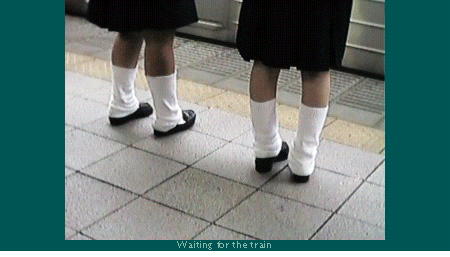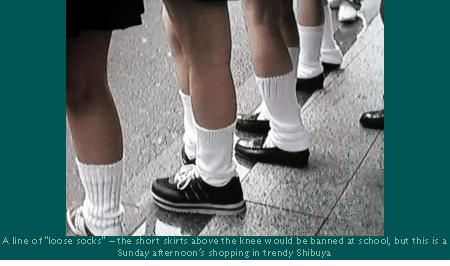We are now in high summer - but the loose socks are still with us. Although I'd written earlier that they seem to be a little passé now, and the trend wasn't so noticeable, I'm not so sure. I found myself noticing a gaggle of schoolgirls the other day, of whom 90% were wearing these loose socks. They're also an essential part of the uniform of the kogaru, whose aim is to appear young (and therefore cute).
The top half is being reduced again and the bare chests are slowly coming back into view. Some of the girls are still wearing very short skirts (in some case, they might be mistaken for wide belts) or really short shorts -- little more than bikini bottoms.
The boys are still (after several years) into fringes of half-beard which look as though they haven't shaved properly (not the "stubble look" - that doesn't work with Japanese, for the most part). If you know Nakata who plays for Italian football clubs, you have an idea what I'm talking about.
Loose socks are perhaps a little more difficult to catch than they used to be, but there are some shots below, as well as more pictures you can see by clicking here.
What are loose socks, anyway?
Also visit the Harajuku page for more Tokyo fashions to amuse and amaze you.
Here are two photographs of the famous loose socks, taken at Shibuya in Tokyo by a friend of mine, Hans Karlsson (he doesn't spend all his time taking pictures of girls' legs -- I asked him to do this for me, as he had one of those Casio digital cameras when I was digicam-less).

As you probably know, there are strict uniform regulations governing what kids are and aren't allowed to wear to school. Sailor suits (a fetish item for many Japanese men) are very common for girls. White socks are the most common form of sock, but the loose socks phenomenon started over a year ago as a protest against school uniforms.
As well as being a protest, they also serve the purpose of making the wearer's legs look thinner by comparison with the baggy floppy socks--a valuable asset in the case of Japanese legs, which are often unkindly referred to as daikon legs -- daikon being the large white cylindrical radish used in Japanese cooking.

There have been previous attempts to push the outside of the uniform envelope in Japan, but they have been restricted to such minor items as the colour of the elastic bands holding girls' hair, and subtle differences in shoe styles. Even though the uniform codes in Japanese schools have been somewhat relaxed recently, it's hard to imagine Japanese teachers condoning such an obviously rule-bending fashion.
The answer seems to be that "normal", tighter socks are worn at school, and the baggy socks are kept in a bag and put on after school. I noticed this, to my surprise, as three girls waiting for an underground train replaced their official socks with their trendy floppy socks, changing them on the platform.
How short can you get?
If the question's about skirts, and you're a Japanese schoolgirl, the answer is, "Not very short". Like so many other aspects of Japanese school uniform, the length of skirts is strictly controlled. However, this didn't stop the three little maids from school on the station platform. As well as changing their socks, they changed their skirts, taking out shorter versions of their school skirts from their bags, putting them on under their official skirts, and then removing the outer skirts. All this on the station platform in full view of the other passengers waiting for the train.
Now equipped with their loose socks and their short skirts, they were ready to: meet their boyfriends? pose in a hamburger shop? go window-shopping? take the train and then walk home? You decide; I didn't follow them. Age? About 14 or 15, I should imagine.
Uniformity is all
I have also witnessed an alternative solution to the problem of wanting to wear a short skirt, but being frustrated by those pesky school regulations. This girl was on a tram, and although it was a Sunday, she had probably been at cram school (uniform is often compulsory there, too). First came an asymmetrical hairdo, performed using elastic bands, using the tram driver's mirror to check the styling. Then came a frantic hitching, twisting and adjustment of the skirt and belt underneath the upper tunic until it was at least 20 centimeters (8 inches) higher than when it started. This took constant adjustment at front and rear, and involved much lifting of the tunic and looking over the shoulder in a glass-covered advertisement in lieu of a mirror to check the rear view. All, again, performed in front of the other passengers on a crowded tram with no visible embarrassment.
Of course, the floppy socks were very much in evidence here as well, but an interesting twist seemed to be that the tops of the socks were falling down off this girl's legs. At least three times in the course of a fifteen-minute journey, we watched her dab some kind of glue on her legs inside the top of the socks. You can buy this sock glue at most convenience stores. The sacrifices we make for fashion!
Rebels or ultra-conformists?
If I seem to be over-emphasising these two aspects of contemporary young Japanese people's fashions, it's because they are obviously a part of a revolt against a literal uniformity imposed by the educational establishments.
The revolt goes far enough to go against what is normally regarded as "decent" behaviour in Japan. For instance, the same girls who changed their skirts in public would almost certainly never want to be seen eating while walking along the street (this is very bad manners in Japan). Despite the general acceptance of depictions of nudity and a generally relaxed attitude to sex in Japan (for example, topless girls, while not an everyday feature of Japanese TV, appear for no obvious reason on a variety of shows), the extremely short skirts are not necessarily a sign of loose morals among the youth of today, even though the sensationalist TV shows and weekly magazines are continually "exposing" scandals involving high-school prostitutes.
It seems that these minor symbols of revolution are no more or less than that -- mere symbols. It can be argued (and probably is) by teachers and parents that short skirts are degenerate and should therefore not be worn by schoolgirls, so it's natural for the girls to outrage the adults by wearing them. It's hard, however, to even begin to think of any reason for banning the loose socks. The only reason for wearing them can be that they're not uniform -- but in a uniquely Japanese way, they break no actual rules, being white, while being a rebellion against uniformity in their styling (it reminds me somewhat of an anarchist friend in the UK who ended up working for IBM, but that's another story...). Unfortunately, the non-conformity has now become so widespread that the girls who stand out are those with the "normal" socks and the "daring" loose socks have become another uniform -- all rather sad. But isn't that the case with all revolutions; today's revolutionary becomes tomorrow's conservative?